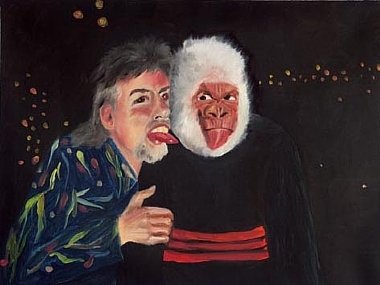Wild Exaggeration
dal 17/7/2009 al 17/8/2009
Segnalato da
Gili Avissar
Boyan
Zoya Cherkassky
Ofri Cnaani
Nathalie Djurberg
Ofir Dor
Oren Eliav
Roey Heifetz
Michal Helfman
Shay Id Alony
Sara Kahana
Yuri Kats
Meital Katz-Minerbo
Katarzyna Kozyra
Marik Lechner
Peter Jacob Maltz
Robert Melee
Assi Meshullam
Adi Nachshon
Gabby Nathan
Sasha Okun
Erwin Olaf
Ada Ovadia
Galia Pasternak
Uri Radovan
Netally Schlosser
Allison Schulnik
Heidi Stern
Anan Tzuckerman
Rakefet Viner Omer
Nadav Weissman
Michal Yaniv
Gil Yefman
Shira Zelwer
ZeroCents
Tami Katz-Freiman
17/7/2009
Wild Exaggeration
Haifa Museum of Art, Haifa
A group exhibition that includes works by Israeli and international artists whose art is characterized by a grotesque quality, and includes representations of the body that allude to this charged and multifaceted cultural term. The exhibition examines an aesthetic category that has become increasingly prevalent in recent years as part of an eccentric, baroque paradigm of self-expression. The grotesque thus reflects a faulty reality and a chaotic world; its bodily incarnation, meanwhile, is presented as both an allegory and as a critique of a fluid subjectivity without clear boundaries, in the context of a postmodern society defined by contradictory and opposing world orders, by excess and by the absence of governing norms.

Curator: Tami Katz-Freiman
"Wild Exaggeration" is a group exhibition that includes works by Israeli and international artists whose art is characterized by a "grotesque" quality, and includes representations of the body that allude to this charged and multifaceted cultural term. The exhibition examines an aesthetic category that has become increasingly prevalent in recent years as part of an eccentric, baroque paradigm of self-expression. The "grotesque" thus reflects a faulty reality and a chaotic world; its bodily incarnation, meanwhile, is presented as both an allegory and as a critique of a fluid subjectivity without clear boundaries, in the context of a postmodern society defined by contradictory and opposing world orders, by excess and by the absence of governing norms.
The term "grotesque" comes from the Italian grotta, or cave, and dates to 16th century archeological discoveries. Excavations made in Italy during this period unearthed ancient Roman wall paintings, which came to be known as grottescas, or grotesques. These fantasy-filled paintings were characterized by anatomical anomalies, small wild animals, human heads and vegetation and images of nymphs, satyrs and centaurs. Qualities associated with caves - such as darkness, chaos, uncertainty and also protection, warmth and security have since become defining elements of the "grotesque." Ever since the Renaissance, this term has been integrated into art historical discourse as a characteristic of works that ignore the rules of symmetry, clarity and order characteristic of the classical world, and which underscore strangeness, hybridity, ambiguity, excess, blurred boundaries, sexuality, distortion and exaggeration. In the 20th century, this term came to be associated with various expressionist trends; in contemporary art, it is revived once again as an aesthetic category embodying a distorted world view.
The common denominator underlying most of the works featured in this exhibition is a concern with the grotesque body - an exaggerated, distorted and ridiculous body that exceeds its own limits, and whose different parts are incompatible with one another. At times it may take the form of a hybrid body composed of animals, objects and plants, while in other instances it appears as an exaggerated and distorted human body. The grotesque body subverts representational conventions concerning the human body, and questions clearcut definitions and boundaries. Despite the structural similarity between various representations of the grotesque, there are evident stylistic differences between the works of different artists. The works included in this exhibition reflect a wide range of artistic approaches to the term "grotesque," ranging from ridicule to cruelty and compassion. At the same time, these works contain a great degree of intellectual, social and political criticism.
The exhibition includes works by Gili Avissar, Boyan, Zoya Cherkassky, Ofri Cnaani, Nathalie Djurberg, Ofir Dor, Oren Eliav, Roey Heifetz, Michal Helfman, Shay Id Alony, Sara Kahana, Yuri Kats, Meital Katz-Minerbo, Katarzyna Kozyra, Marik Lechner, Peter Jacob Maltz, Robert Melee, Assi Meshullam, Adi Nachshon, Gabby Nathan, Sasha Okun, Erwin Olaf, Ada Ovadia, Galia Pasternak, Uri Radovan, Netally Schlosser, Allison Schulnik, Heidi Stern, Anan Tzuckerman, Rakefet Viner Omer, Nadav Weissman, Michal Yaniv, Gil Yefman, Shira Zelwer, ZeroCents.
Image: Galia Pasternak, Drunk Man and Gorilla, 2006
Press contact:
Hagit Asaf, Public Relations
Phone: 04-9115990 marketing@hms.org.il
Opening: July 18, 2009
Haifa Museum of Art
26 Shabbetai Levi Street - Haifa
Hours
Sun, Mon, Tue, Wed 10:00 a.m. - 4:00 p.m.
Thu 4:00 p.m. - 7:00 p.m.
Fridays and holiday eves 10:00 a.m. - 1:00 p.m.
Saturdays and holidays 10:00 a.m. - 3:00 p.m.



